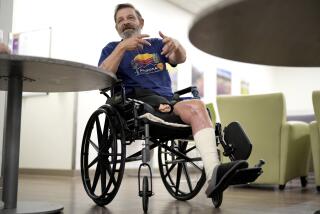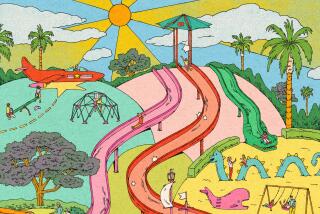Playing It Safe
- Share via
The day was filled with promise. It was sunny, and our family was off to the zoo: children, parents, aunts and uncles, grandparents.
But within five minutes of arriving, the outing ended abruptly, sorrowfully.
My 6-year-old nephew jogged over to a small playground, hoisted himself up on the monkey bars and lost his grip on bars too thick for his small hands. He plunged to the ground, landing on a thin layer of wood chips, his forearm badly broken and dangling at his side.
How is it that playgrounds, where children go to revel in all their youthful energy, too often become places of sadness for families?
More than half a million children are injured on playground equipment each year, according to the American Academy of Orthopedic Surgeons. Roughly 150,000 of those injuries are serious, and an average of 15 children die each year in playground accidents.
Although some injuries are rare and freakish, the majority of the mishaps are linked to common playground elements: swings, climbing equipment and slides.
So commonplace are the hazards that a 1998 report by two consumer advocacy groups concluded that the majority of America’s public playgrounds pose serious dangers to children.
Despite ample information about the elements of safer playgrounds, “we haven’t seen the type of improvements we really need to reduce injuries,” says Darrell Hammond, chief executive of Kaboom, a Washington, D.C.-based nonprofit group that promotes playground safety.
Only a handful of states--California, Michigan, New Jersey and Texas--have passed comprehensive playground safety laws. The California law, which goes into effect in October and is one of the most stringent, mandates playground inspections, upkeep and adherence to minimal safety standards.
Doctors are also playing a role in raising awareness of the issue. The American Academy of Orthopedic Surgeons has launched a new public service campaign to promote appropriate playground behavior for children and parents.
Marcia Kerr, a spokeswoman for the federal Consumer Products Safety Commission, sees a “momentum to improve playgrounds.” The California law, she says, has prompted a lot of inquiries from playground owners seeking to comply with the new rules.
*
While playground safety has been a topic of concern for decades, past attempts to improve conditions have been piecemeal, such as a federal regulation that banned unsafe teeter-totters, Hammond says.
Another group that is responding to safety concerns is playground manufacturers. They are introducing new playground structures aimed at reducing serious injuries and improving access to all children, including disabled children.
According to design experts, safe playgrounds today are notably different from the ones built in the 1970s or earlier. For example, themed playgrounds (such as a playground constructed to resemble a ship) and those with access for disabled children (such as one now under construction in Griffith Park) are gaining in popularity.
While swings and slides are still in demand, carousels and whirls have fallen out of favor due to high injury rates, says Kevin Owens, director of Fun New Stuff for Playworld Systems, a leading playground manufacturer in Lewisburg, Pa.
For a while in the 1990s, some playground owners began eliminating taller structures out of concern over injuries. But the Consumer Product Safety Commission has not issued a regulation on structure height, and designers today are not shying away from building towering play areas.
“Although it’s fairly widely known that falls are the major source of injuries, that doesn’t necessarily mean falls from great height,” Owens says. “There wasn’t [data] to back up a height regulation.”
Safety concerns have also prompted playground designers to reduce the number of moving parts in equipment such as swings, merry-go-rounds and rocking horses. But some say that shorter structures and fewer moving parts could make playgrounds less inviting to children.
“I think we have to balance the needs of a safe playground without compromising a child’s fun,” Hammond says.
Owens agrees that children won’t use a playground if it doesn’t present some perceived physical challenge.
“In order to meet kids’ needs for taking risks and facing challenges, you need to have a certain amount of height and the illusion of risk, even though there isn’t really risk,” Owens says.
The goal of communities should be to eliminate serious injuries while recognizing that minor accidents will happen when kids cut loose to play, Owens says.
Even more important than equipment design is the playground’s surface. Among the surfaces considered safe are rubber tiles or loose fill, such as properly shredded mulch or shredded rubber. In most cases, loose-fill surfaces should be about 12 inches thick, depending on the height of the play structure, Owens says.
*
Playground owners often make the mistake of installing a playground and then failing to maintain it. Such surfaces as sand or bark chips, for example, need regular attention.
“You can’t build a playground today and think it’s going to be safe in six weeks,” Hammond says. “It requires daily, weekly and monthly inspection and care.”
Daily maintenance includes picking up trash, raking loose-fill surfaces to redistribute the material and wiping off standing water.
Bolts should be checked monthly and all parts oiled, cleaned and sterilized, if necessary, annually, Hammond says.
Parents or caregivers can bear some of the responsibility for playground safety, helping to keep play areas clean and reporting equipment in disrepair to the appropriate person.
Under California’s new law, playground owners will have to meet federal standards and those issued by the American Society for Testing and Materials. The initial evaluation must be completed by October. The inspections can be conducted by anyone who has been certified by the National Parks and Recreation Assn.’s National Playground Safety Institute in Ashburn, Va. Owners have until 2003 to bring their playgrounds into compliance.
During the inspection process, the owner and inspector will come up with a schedule for future inspections, says Barb Alberson, chief of the state and local injury control section of the California Department of Health Services.
Playground equipment is only one half of the safety equation. Children’s behavior and adult supervision make a difference in the injury rate.
“A lot of parents think the playground is an outdoor baby-sitter,” Hammond says. “Parents need to go with their children to the playground and supervise them.”
*
In a new media campaign, the American Academy of Orthopedic Surgeons urges parents to monitor their kids’ playground behavior and warns kids about the hazards of misusing equipment.
The campaign notes that many children are tempted to leap off a twirling merry-go-round, go headfirst down the slide or catapult from a swing after reaching maximum height and speed.
“There is a great deal of parental responsibility that goes into this,” says Dr. Stuart Hirsch, chairman of the American Academy of Orthopedic Surgeons’ council on communications. “Parents can see that children are at the right place at the right time for their development, age and level of coordination.”
According to Hirsch, playground equipment has become much safer. Improvements in children’s use of the equipment could be the deciding factor to reduce the high injury rate.
“I think most parents see a playground, and assume safety is a given,” he says. “But if we advocate for safety and raise awareness, we can really cut the number of injuries dramatically.”
(BEGIN TEXT OF INFOBOX / INFOGRAPHIC)
Where Injuries Occur
Swings: 180,876
Climbing equipment: 189,767
Slides: 117,979
Teeter-totters and seesaws: 13,167
Other: 67,272
Source: U.S. Consumer Product Safety Commission; 1998 figures; children under 15.
How Children Are Hurt:
* Child falls onto a surface or strikes steps, poles or other equipment.
* Child collides with moving swings, merry-go-rounds or teeter-totters.
* Drawstrings from hooded sweatshirt catch on a piece of playground equipment and strangle the child.
* Spring rocker coils can severely pinch a child’s hand or foot.
* Child wearing a bicycle helmet becomes entrapped in an opening, such as a horizontal ladder, causing strangulation.
* Child is burned on metal slides that become excessively hot in warm weather.
*
Source: U.S. Consumer Product Safety Commission, 1998 figures for children under 15.
(BEGIN TEXT OF INFOBOX / INFOGRAPHIC)
Playground Safety Check:
Slides
Should have side guards at the top.
The slope should be no more than 30 degrees, with a flat, horizontal section at the bottom.
Swings
Seats should be placed 24 inches apart and should be at least 30 inches from the side frame.
Platforms and Railings
Elevated areas, such as platforms and ramps, should have guardrails to prevent falls.
Playground Surfaces
Surfaces should be safety-tested rubber or at least 12 inches deep with wood chips, mulch, sand or pea gravel.
Protective surfacing should extend at least 6 feet in all directions from play equipment.
Borders around play areas should be rubber rather than concrete or asphalt.
Footings should not be exposed.
No protruding bolts or S-hooks.
Clearance and spacing
Spaces or openings in structures should measure less than 3 1/2 inches or more than 9 inches to avoid an opening that could trap a child’s head.
Play structures exceeding heights of 30 inches should be placed at least 9 feet apart.
Access
For disabled children, playgrounds should have a transfer module or a ramp to provide proper access.
Playgrounds should have features allowing kids to develop tactile and auditory skills.
Some Playground Hazards
Surfaces made of concrete, asphalt, hard-packed dirt or grass.
Metal or wood swing seats.
Loose, damaged or missing supports, anchors or footings.
Splintered or deteriorated wood.
Visibly deteriorated or missing surfacing materials.
Loose, damaged or missing nuts and bolts.
Broken seats.
Bent, rusted or warped components.
Missing protective end caps for bolts or tubes.
Broken, missing or loose steps, rungs, guardrails or handrails.
Sources: American Academy of Orthopedic Surgeons, Consumer Product Safety Commission.
(BEGIN TEXT OF INFOBOX / INFOGRAPHIC)
Safety Tips for Kids
* One person at a time on the slide.
* Slide sitting down and facing forward.
* Move away from the slide exit as soon as you reach the ground.
* Climb stairs or steps slowly.
Wear proper footwear: No bare feet.
* Hold on to handrails.
* Avoid climbing or sliding on equipment support poles or beams.
* Don’t stand up on swings; don’t jump off swings in motion.
* Take off bicycle helmets when on the playground.
* Don’t wear sweatshirts with drawstrings.
Source: American Academy of Orthopedic Surgeons
More to Read
Sign up for Essential California
The most important California stories and recommendations in your inbox every morning.
You may occasionally receive promotional content from the Los Angeles Times.













